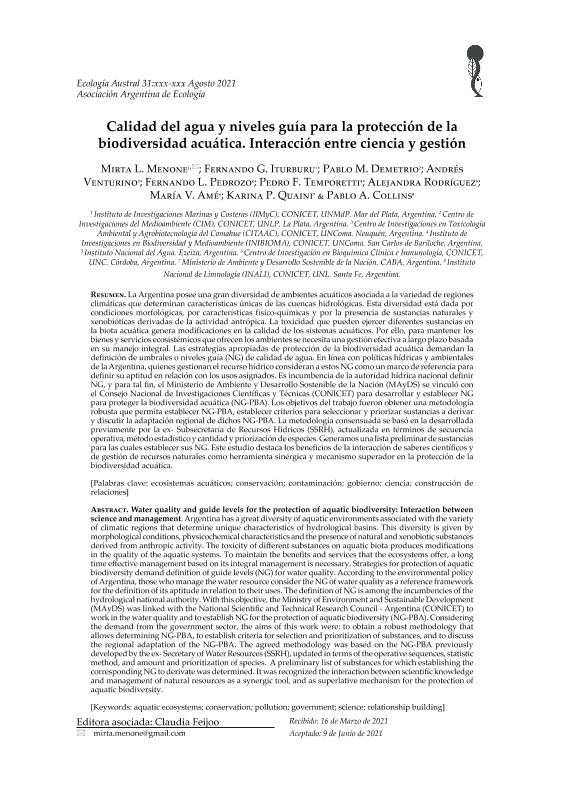Artículo
La Argentina posee una gran diversidad de ambientes acuáticos asociada a la variedad de regiones climáticas que determinan características únicas de las cuencas hidrológicas. Esta diversidad está dada por condiciones morfológicas, por características físico-químicas y por la presencia de sustancias naturales y xenobióticas derivadas de la actividad antrópica. La toxicidad que pueden ejercer diferentes sustancias en la biota acuática genera modificaciones en la calidad de los sistemas acuáticos. Por ello, para mantener los bienes y servicios ecosistémicos que ofrecen los ambientes se necesita una gestión efectiva a largo plazo basada en su manejo integral. Las estrategias apropiadas de protección de la biodiversidad acuática demandan la definición de umbrales o niveles guía (NG) de calidad de agua. En línea con políticas hídricas y ambientales de la Argentina, quienes gestionan el recurso hídrico consideran a estos NG como un marco de referencia para definir su aptitud en relación con los usos asignados. Es incumbencia de la autoridad hídrica nacional definir NG, y para tal fin, el Ministerio de Ambiente y Desarrollo Sostenible de la Nación (MAyDS) se vinculó con el Consejo Nacional de Investigaciones Científicas y Técnicas (CONICET) para desarrollar y establecer NG para proteger la biodiversidad acuática (NG-PBA). Los objetivos del trabajo fueron obtener una metodología robusta que permita establecer NG-PBA, establecer criterios para seleccionar y priorizar sustancias a derivar y discutir la adaptación regional de dichos NG-PBA. La metodología consensuada se basó en la desarrollada previamente por la ex- Subsecretaría de Recursos Hídricos (SSRH), actualizada en términos de secuencia operativa, método estadístico y cantidad y priorización de especies. Generamos una lista preliminar de sustancias para las cuales establecer sus NG. Este estudio destaca los beneficios de la interacción de saberes científicos y de gestión de recursos naturales como herramienta sinérgica y mecanismo superador en la protección de la biodiversidad acuática. Argentina has a great diversity of aquatic environments associated with the variety of climatic regions that determine unique characteristics of hydrological basins. This diversity is given by morphological conditions, physicochemical characteristics and the presence of natural and xenobiotic substances derived from anthropic activity. The toxicity of different substances on aquatic biota produces modifications in the quality of the aquatic systems. To maintain the benefits and services that the ecosystems offer, a long time effective management based on its integral management is necessary. Strategies for protection of aquatic biodiversity demand definition of guide levels (NG) for water quality. According to the environmental policy of Argentina, those who manage the water resource consider the NG of water quality as a reference framework for the definition of its aptitude in relation to their uses. The definition of NG is among the incumbencies of the hydrological national authority. With this objective, the Ministry of Environment and Sustainable Development (MAyDS) was linked with the National Scientific and Technical Research Council - Argentina (CONICET) to work in the water quality and to establish NG for the protection of aquatic biodiversity (NG-PBA). Considering the demand from the government sector, the aims of this work were: to obtain a robust methodology that allows determining NG-PBA, to establish criteria for selection and prioritization of substances, and to discuss the regional adaptation of the NG-PBA. The agreed methodology was based on the NG-PBA previously developed by the ex- Secretary of Water Resources (SSRH), updated in terms of the operative sequences, statistic method, and amount and prioritization of species. A preliminary list of substances for which establishing the corresponding NG to derivate was determined. It was recognized the interaction between scientific knowledge and management of natural resources as a synergic tool, and as superlative mechanism for the protection of aquatic biodiversity.
Calidad del agua y niveles guía para la protección de la biodiversidad acuática. Interacción entre ciencia y gestión
Título:
Water quality and guide levels for the protection of aquatic biodiversity: Interaction between science and management
Menone, Mirta Lujan ; Iturburu, Fernando Gastón
; Iturburu, Fernando Gastón ; Demetrio, Pablo Martin
; Demetrio, Pablo Martin ; Venturino, Andres
; Venturino, Andres ; Pedrozo, Fernando Luis
; Pedrozo, Fernando Luis ; Temporetti, Pedro Felix
; Temporetti, Pedro Felix ; Rodríguez, Alejandra; Amé, María Valeria
; Rodríguez, Alejandra; Amé, María Valeria ; Quaíni, Karina P.; Collins, Pablo Agustin
; Quaíni, Karina P.; Collins, Pablo Agustin
 ; Iturburu, Fernando Gastón
; Iturburu, Fernando Gastón ; Demetrio, Pablo Martin
; Demetrio, Pablo Martin ; Venturino, Andres
; Venturino, Andres ; Pedrozo, Fernando Luis
; Pedrozo, Fernando Luis ; Temporetti, Pedro Felix
; Temporetti, Pedro Felix ; Rodríguez, Alejandra; Amé, María Valeria
; Rodríguez, Alejandra; Amé, María Valeria ; Quaíni, Karina P.; Collins, Pablo Agustin
; Quaíni, Karina P.; Collins, Pablo Agustin
Fecha de publicación:
08/2021
Editorial:
Asociación Argentina de Ecología
Revista:
Ecología Austral
ISSN:
0327-5477
Idioma:
Español
Tipo de recurso:
Artículo publicado
Clasificación temática:
Resumen
Archivos asociados
Licencia
Identificadores
Colecciones
Articulos (CIM)
Articulos de CENTRO DE INVESTIGACIONES DEL MEDIO AMBIENTE
Articulos de CENTRO DE INVESTIGACIONES DEL MEDIO AMBIENTE
Articulos(CITAAC)
Articulos de CENTRO DE INVESTIGACIONES EN TOXICOLOGIA AMBIENTAL Y AGROBIOTECNOLOGIA DEL COMAHUE
Articulos de CENTRO DE INVESTIGACIONES EN TOXICOLOGIA AMBIENTAL Y AGROBIOTECNOLOGIA DEL COMAHUE
Articulos(IIMYC)
Articulos de INSTITUTO DE INVESTIGACIONES MARINAS Y COSTERAS
Articulos de INSTITUTO DE INVESTIGACIONES MARINAS Y COSTERAS
Articulos(INALI)
Articulos de INST.NAC.DE LIMNOLOGIA (I)
Articulos de INST.NAC.DE LIMNOLOGIA (I)
Articulos(INIBIOMA)
Articulos de INST. DE INVEST.EN BIODIVERSIDAD Y MEDIOAMBIENTE
Articulos de INST. DE INVEST.EN BIODIVERSIDAD Y MEDIOAMBIENTE
Citación
Menone, Mirta Lujan; Iturburu, Fernando Gastón; Demetrio, Pablo Martin; Venturino, Andres; Pedrozo, Fernando Luis; et al.; Calidad del agua y niveles guía para la protección de la biodiversidad acuática. Interacción entre ciencia y gestión; Asociación Argentina de Ecología; Ecología Austral; 8-2021; 1-13
Compartir
Altmétricas



